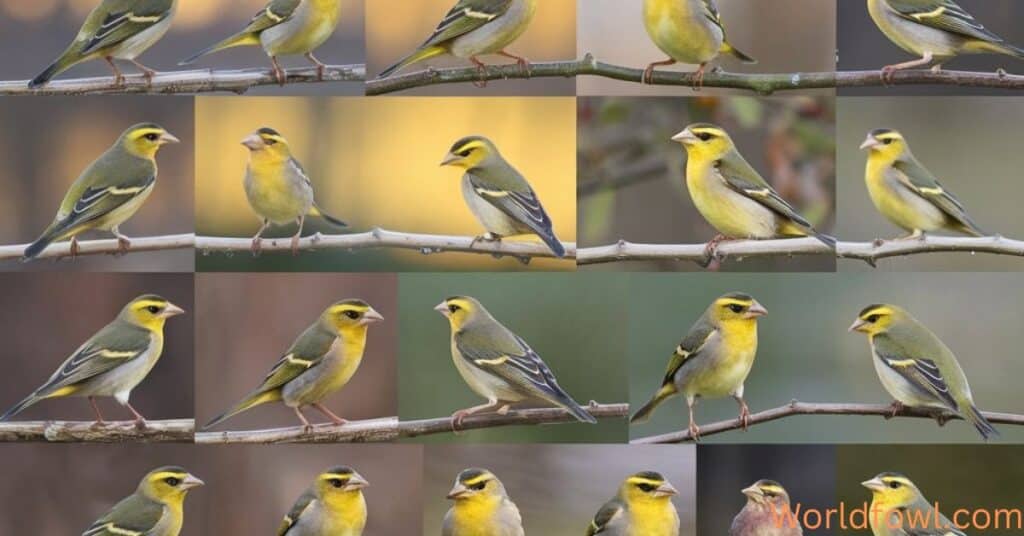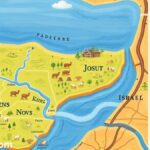Ohio’s diverse landscapes, from rolling hills to lush forests and expansive wetlands, pro vide a haven for an array of stunning Yellow Birds In Ohio. These golden-hued beauties add a splash of sunshine to the Buckeye State’s rich avian tapestry. Whether you’re an avid birder or a casual nature enthusiast, this comprehensive guide will introduce you to 24 remarkable yellow bird species that call Ohio home, either year-round or during migration.
Introduction: Yellow Birds In Ohio
Ohio’s geographical location along major flyways makes it a prime spot for observing a wide variety of bird species. The state’s diverse habitats, including deciduous forests, prairies, and Lake Erie shorelines, attract both resident and migratory birds. Among these, yellow birds stand out with their vibrant plumage, catching the eye of observers and playing crucial roles in local ecosystems.
This guide will take you on a journey through the world of yellow birds in Ohio, from the familiar American Goldfinch to the elusive Prothonotary Warbler. We’ll explore their characteristics, habitats, behaviors, and the best times and places to spot them. So grab your binoculars, and let’s dive into the golden world of Ohio’s feathered friends!
Vireos: The Melodious Foliage-Dwellers
Vireos are small to medium-sized songbirds known for their melodious calls and preference for leafy habitats. Ohio is home to several vireo species, including some with distinctive yellow plumage.
Philadelphia Vireo: The Subtle Songster
The Philadelphia Vireo (Vireo philadelphicus) is a charming little bird with a subtle yellow wash on its underparts. Despite its name, it’s more likely to be found in Ohio than in Philadelphia during migration seasons.
Key Features:
- Length: 4.3-5.1 inches
- Wingspan: 7.5-8.7 inches
- Weight: 0.3-0.5 ounces
Habitat and Behavior:
- Prefers deciduous and mixed forests
- Often found high in the canopy, making it challenging to spot
- Feeds primarily on insects, gleaning them from leaves and branches
Best Time to Spot: Look for Philadelphia Vireos during spring and fall migrations, typically in May and September.
Yellow-throated Vireo: The Bold Canopy Dweller
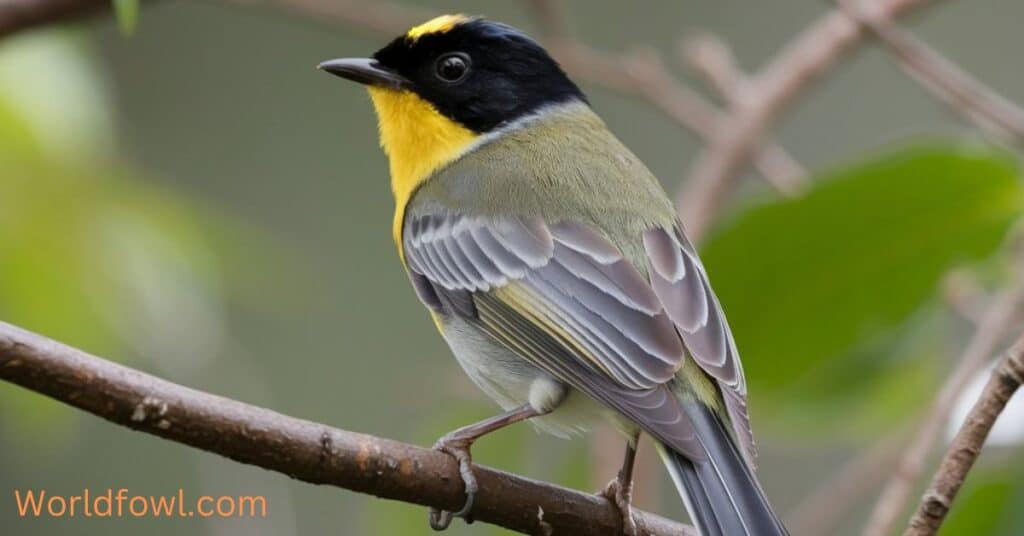
The Yellow-throated Vireo (Vireo flavifrons) is a striking bird with a bright yellow throat and breast, making it one of the most colorful vireos in Ohio.
Key Features:
- Length: 5.1-5.9 inches
- Wingspan: 9.1-9.8 inches
- Weight: 0.5-0.7 ounces
Habitat and Behavior:
- Inhabits mature deciduous and mixed forests
- Often seen foraging high in the tree canopy
- Has a distinctive song, described as “three-eight”
Best Time to Spot: Yellow-throated Vireos are present in Ohio from late April through September.
you might also like : Do Owls Poop – The Juicy Truth
Warbling Vireo: The Gentle Gleaner
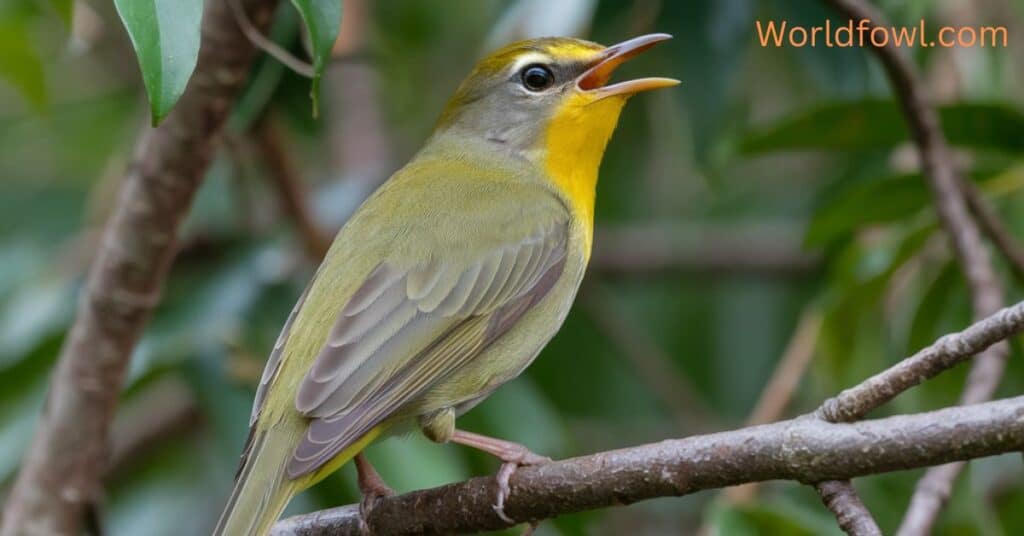
The Warbling Vireo (Vireo gilvus) is a more subdued yellow bird, with a pale yellow wash on its underparts. Its gentle, warbling song is a common sound in Ohio’s woodlands.
Key Features:
- Length: 4.7-5.1 inches
- Wingspan: 7.9-8.7 inches
- Weight: 0.4-0.6 ounces
Habitat and Behavior:
- Found in a variety of wooded habitats, including urban parks
- Often seen foraging for insects in treetops
- Known for its continuous, melodious warbling song
Best Time to Spot: Warbling Vireos are present in Ohio from late April through September.
Finches: Yellow Birds In Ohio
Finches are small, seed-loving birds known for their conical bills and often colorful plumage. Ohio is home to several yellow finch species, including the state bird.
American Goldfinch: Ohio’s State Bird
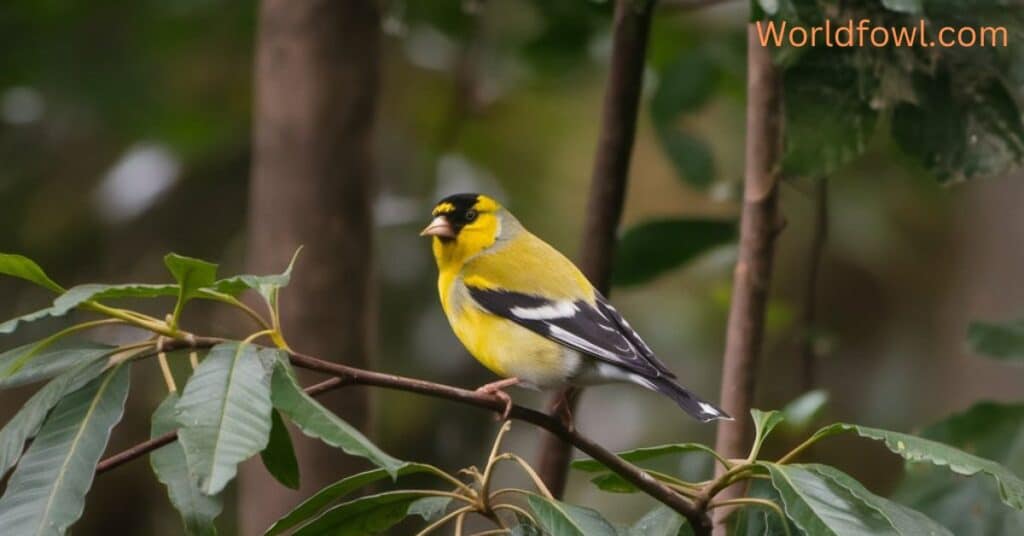
The American Goldfinch (Spinus tristis) is perhaps the most well-known yellow bird in Ohio, having been designated the state bird in 1933.
Key Features:
- Length: 4.3-5.1 inches
- Wingspan: 7.5-8.7 inches
- Weight: 0.4-0.7 ounces
Habitat and Behavior:
- Found in open areas with scattered trees and shrubs
- Frequents bird feeders, especially those offering nyjer seeds
- Males sport bright yellow plumage in summer, while females are more olive-colored
Best Time to Spot: American Goldfinches are year-round residents in Ohio, but males are most vibrant during the breeding season from late spring through summer.
you can also read : Why Are House Sparrows Bad? Reasons and Solutions
Evening Grosbeak: The Winter Visitor
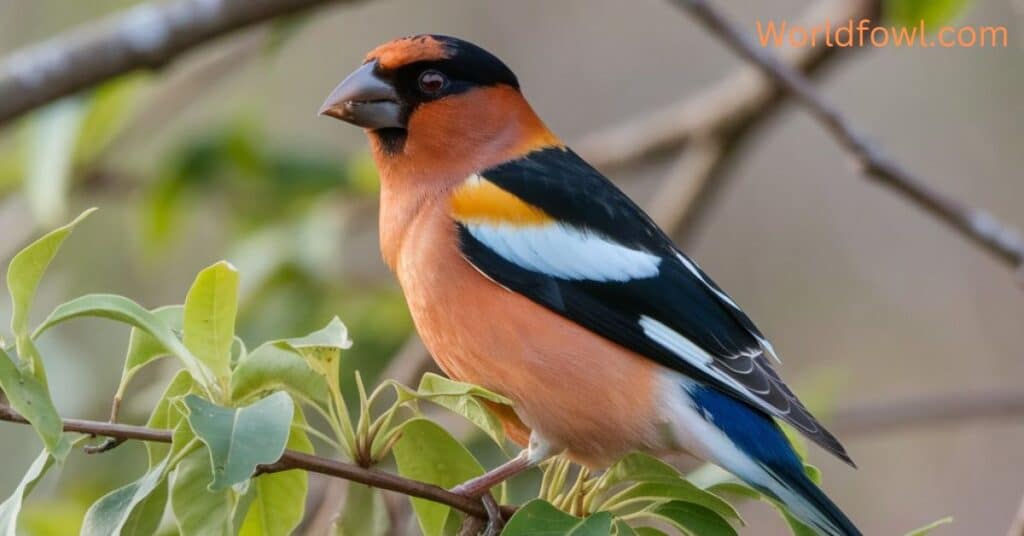
The Evening Grosbeak (Coccothraustes vespertinus) is a large, stocky finch that occasionally visits Ohio during winter irruptions.
Key Features:
- Length: 6.3-7.1 inches
- Wingspan: 11.8-14.2 inches
- Weight: 1.9-2.6 ounces
Habitat and Behavior:
- Prefers coniferous and mixed forests
- Often seen in flocks at bird feeders during irruption years
- Has a massive, pale greenish-yellow bill
Best Time to Spot: Evening Grosbeaks are irregular winter visitors to Ohio, typically arriving in November and departing by April.
Pine Siskin: The Nomadic Northerner
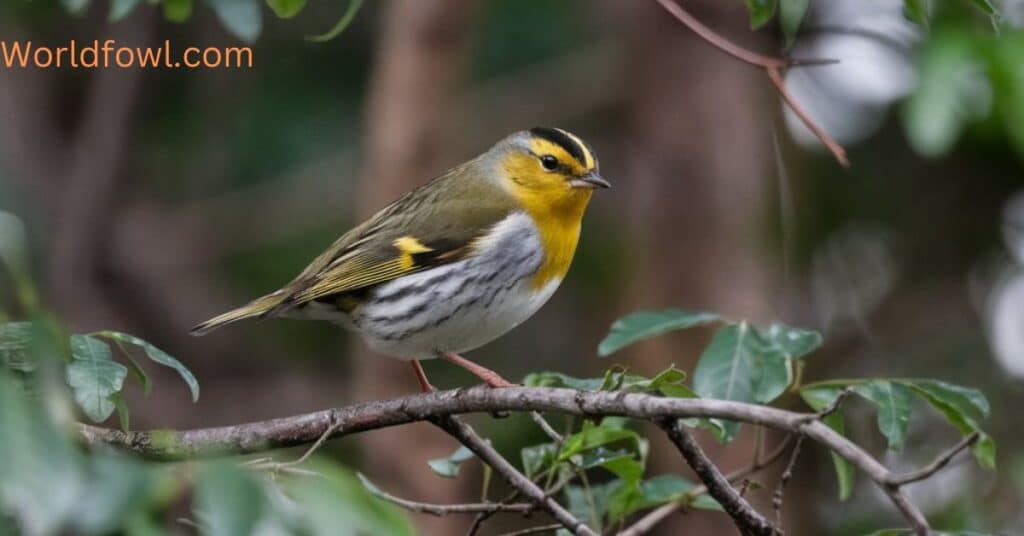
The Pine Siskin (Spinus pinus) is a small finch with subtle yellow markings on its wings and tail.
Key Features:
- Length: 4.3-5.5 inches
- Wingspan: 7.1-8.7 inches
- Weight: 0.4-0.6 ounces
Habitat and Behavior:
- Found in coniferous forests and mixed woodlands
- Often seen in large flocks, especially at feeders during winter
- Has a distinctive, buzzy call and song
Best Time to Spot: Pine Siskins are irregular winter visitors to Ohio, with numbers varying from year to year.
Blackbirds and Orioles: The Striking Meadow Dwellers
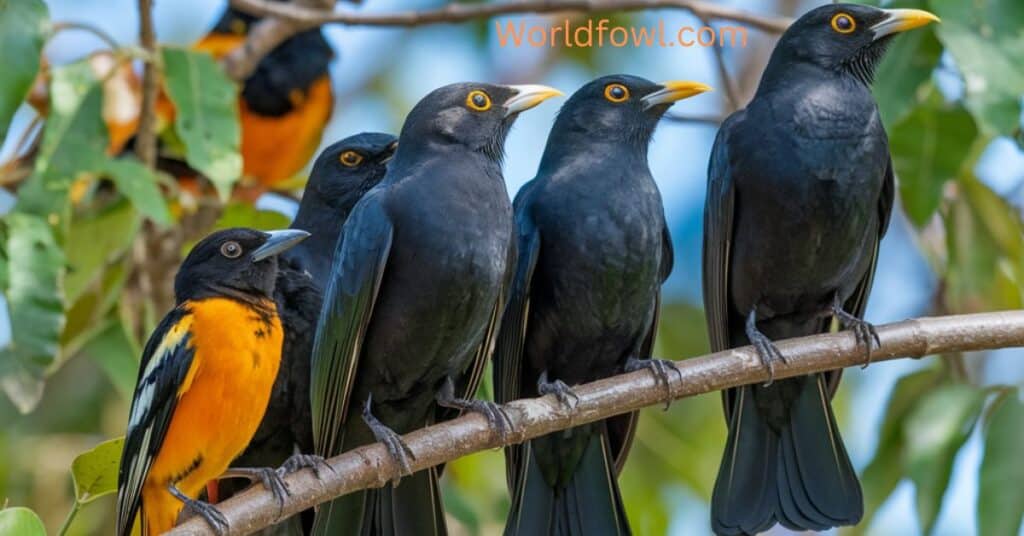
This group includes some of Ohio’s most distinctive yellow birds, ranging from grassland specialists to forest-dwelling weavers.
you might like : Do Hawks Hunt At Night – The Truth Revealed
Eastern Meadowlark: The Prairie Songster
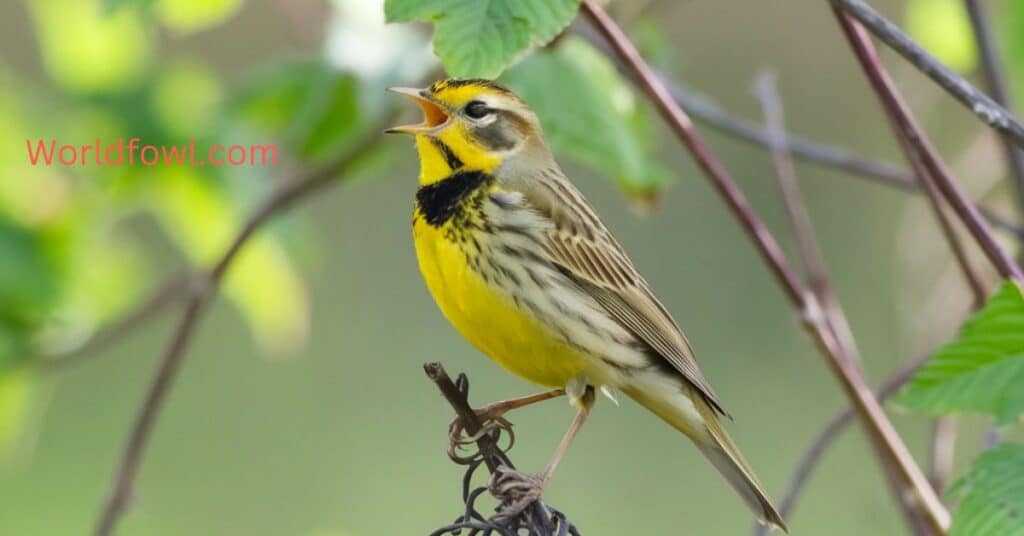
The Eastern Meadowlark (Sturnella magna) is a striking bird of open grasslands, known for its melodious flute-like song.
Key Features:
- Length: 7.5-10.2 inches
- Wingspan: 13.8-15.8 inches
- Weight: 3.2-5.3 ounces
Habitat and Behavior:
- Inhabits grasslands, pastures, and agricultural fields
- Feeds primarily on insects and seeds on the ground
- Has a distinctive black “V” on its bright yellow breast
Best Time to Spot: Eastern Meadowlarks are year-round residents in Ohio, but are most visible and vocal during the breeding season from April to July.
Western Meadowlark: The Rare Ohio Visitor
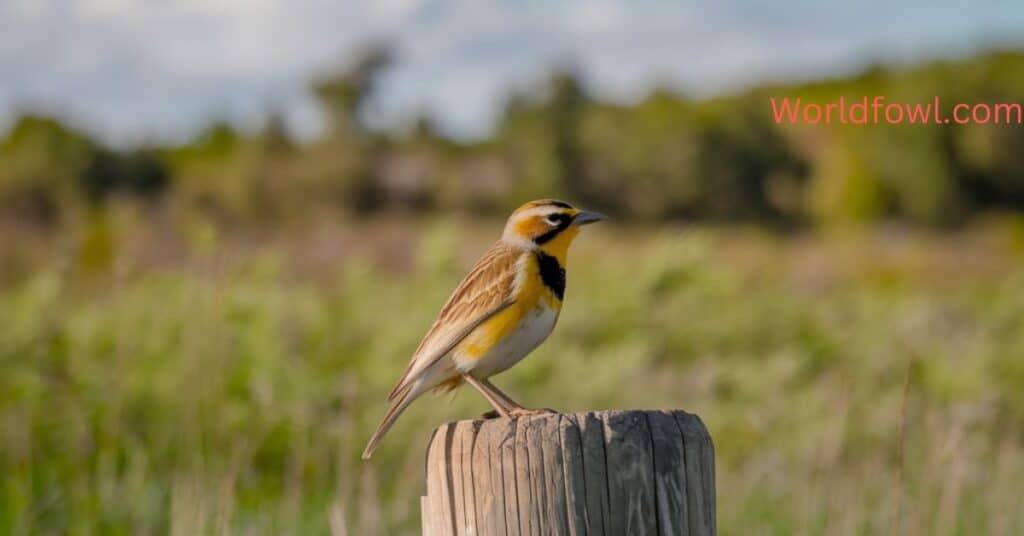
The Western Meadowlark (Sturnella neglecta) is similar to its eastern counterpart but is a rare visitor to Ohio.
Key Features:
- Length: 6.3-10.2 inches
- Wingspan: 13.8-15.8 inches
- Weight: 3.1-4.1 ounces
Habitat and Behavior:
- Prefers similar habitats to the Eastern Meadowlark
- Has a slightly different song, described as more flute-like and melodious
- Very rare in Ohio, with occasional sightings in western parts of the state
Best Time to Spot: Western Meadowlarks are extremely rare in Ohio, with sporadic sightings typically occurring during spring and fall migrations.
Yellow-headed Blackbird: The Marsh Musician
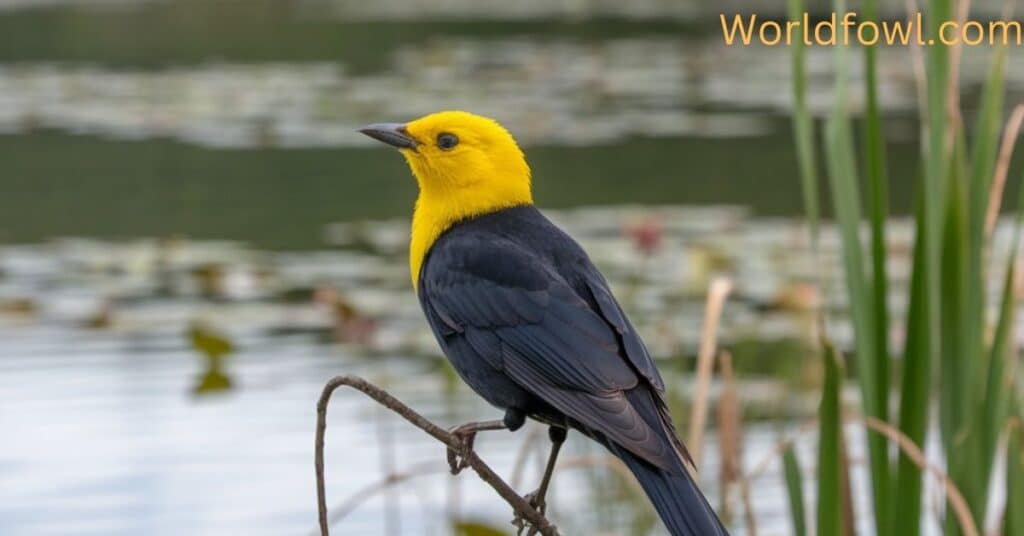
The Yellow-headed Blackbird (Xanthocephalus xanthocephalus) is a striking bird with a bright yellow head and breast contrasting with a black body.
Key Features:
- Length: 8.3-10.2 inches
- Wingspan: 16.5-17.3 inches
- Weight: 1.6-3.5 ounces
Habitat and Behavior:
- Inhabits marshes and wetlands
- Feeds on insects and seeds
- Has a distinctive, harsh call often described as sounding like a rusty gate
Best Time to Spot: Yellow-headed Blackbirds are rare visitors to Ohio, occasionally seen during spring and fall migrations.
you can also read : Do Vultures Attack Humans? Here’s What You Need To Know
Baltimore Oriole: The Flame-Orange Weaver
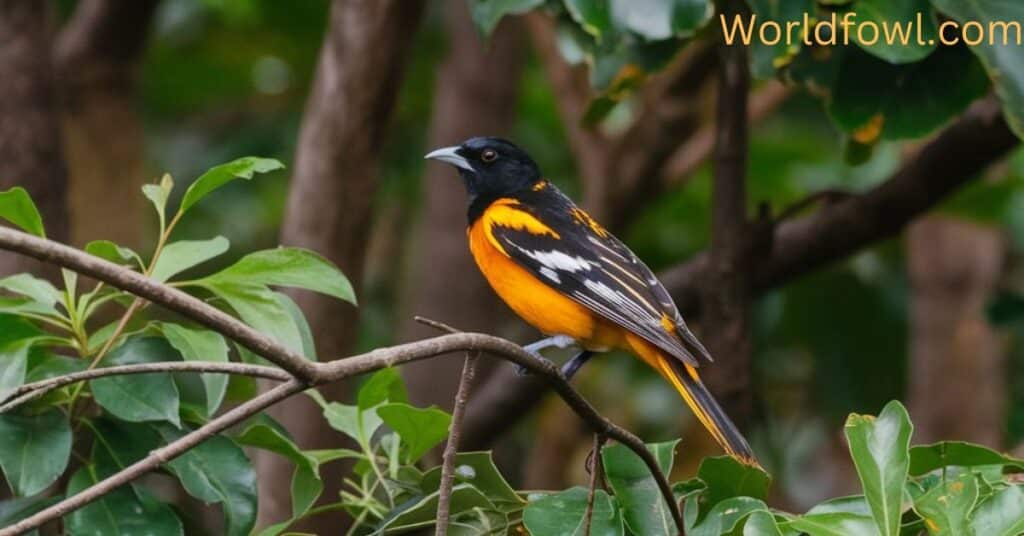
The Baltimore Oriole (Icterus galbula) is a stunning bird with bright orange and black plumage, often with yellow undertones.
Key Features:
- Length: 6.7-7.5 inches
- Wingspan: 9.1-11.8 inches
- Weight: 1.1-1.4 ounces
Habitat and Behavior:
- Found in open woodlands, forest edges, and urban parks
- Known for weaving intricate hanging nests
- Feeds on insects, fruit, and nectar
Best Time to Spot: Baltimore Orioles are present in Ohio from late April through early September.
Orchard Oriole: The Rusty Acrobat
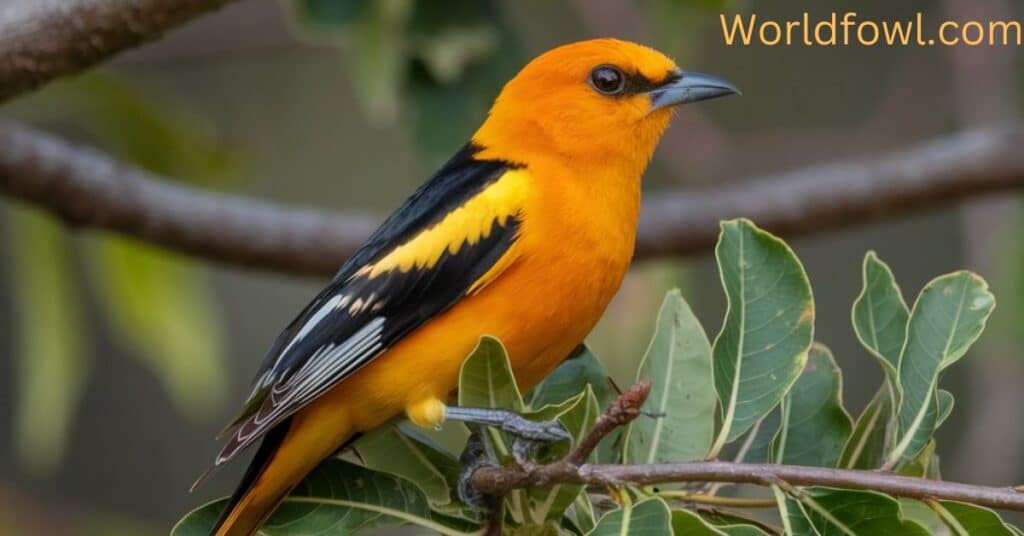
The Orchard Oriole (Icterus spurius) is a smaller oriole species with a more subdued coloration, featuring rusty-orange and black plumage.
Key Features:
- Length: 5.9-7.1 inches
- Wingspan: 9.8 inches
- Weight: 0.6-1.0 ounces
Habitat and Behavior:
- Prefers open woodlands, orchards, and riparian areas
- Known for its acrobatic foraging behavior
- Feeds on insects, fruit, and nectar
Best Time to Spot: Orchard Orioles are present in Ohio from early May through late August.
Warblers: The Jewels of Ohio’s Forests
Warblers are small, often brightly colored songbirds that pass through Ohio during migration or nest in the state’s diverse habitats. Many warbler species feature yellow in their plumage, making them some of the most sought-after birds for enthusiasts.
Blue-winged Warbler: The Golden-Crowned Buzzer
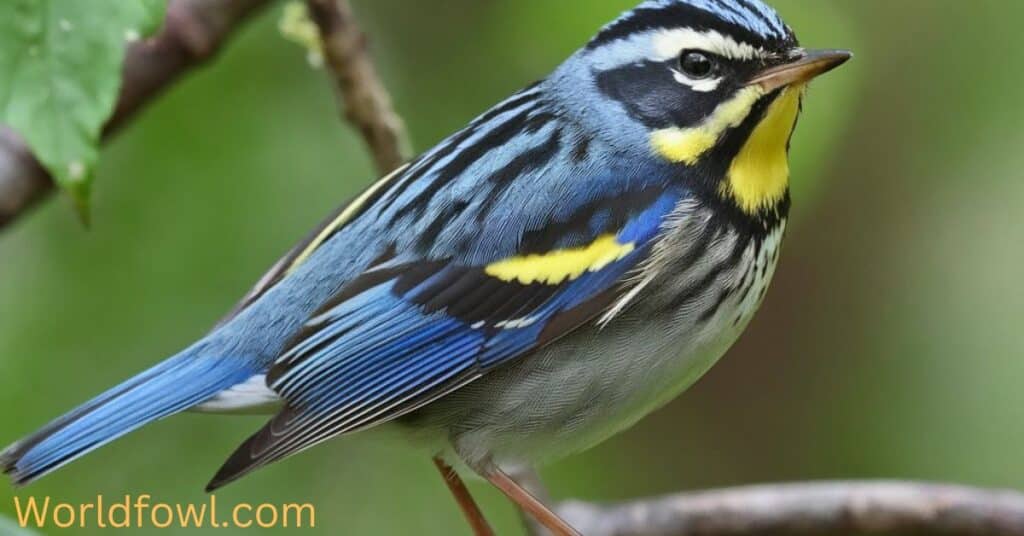
The Blue-winged Warbler (Vermivora cyanoptera) is a striking bird with a golden-yellow body and blue-gray wings.
Key Features:
- Length: 4.3-4.7 inches
- Wingspan: 6.7-7.5 inches
- Weight: 0.3-0.4 ounces
Habitat and Behavior:
- Inhabits shrubby fields and forest edges
- Known for its distinctive “bee-buzz” song
- Feeds primarily on insects and spiders
Best Time to Spot: Blue-winged Warblers are present in Ohio from late April through early September.
Canada Warbler: The Necklaced Beauty
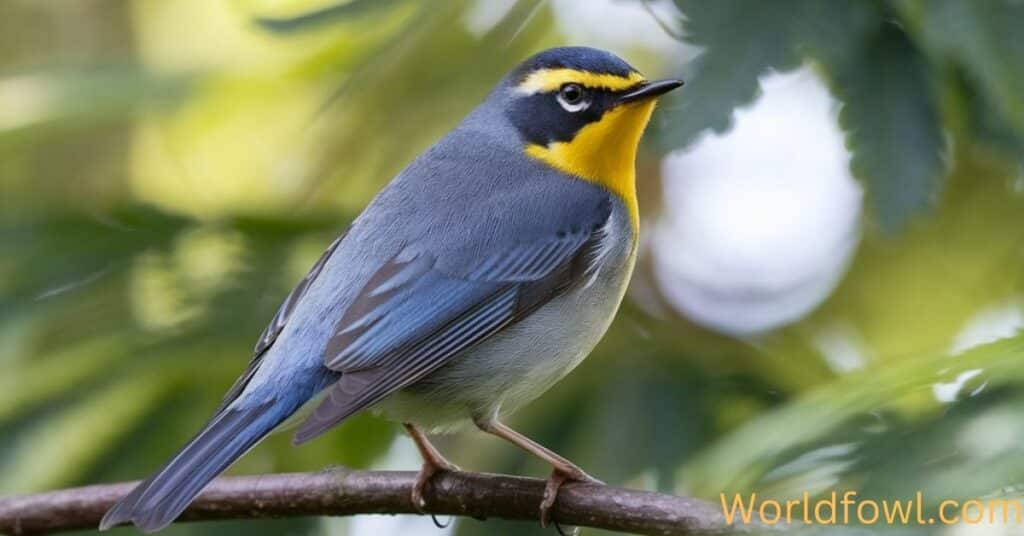
The Canada Warbler (Cardellina canadensis) is a striking bird with a bright yellow underside and a distinctive black necklace.
Key Features:
- Length: 5.1-5.9 inches
- Wingspan: 6.7-8.7 inches
- Weight: 0.3-0.5 ounces
Habitat and Behavior:
- Prefers dense understory in moist, mixed forests
- Feeds on flying insects, often catching them in mid-air
- Known for its rapid, chattering song
Best Time to Spot: Canada Warblers are migrating warblers in Ohio, typically seen in May and again in late August through September.
Cape May Warbler: The Tiger-Striped Migrant
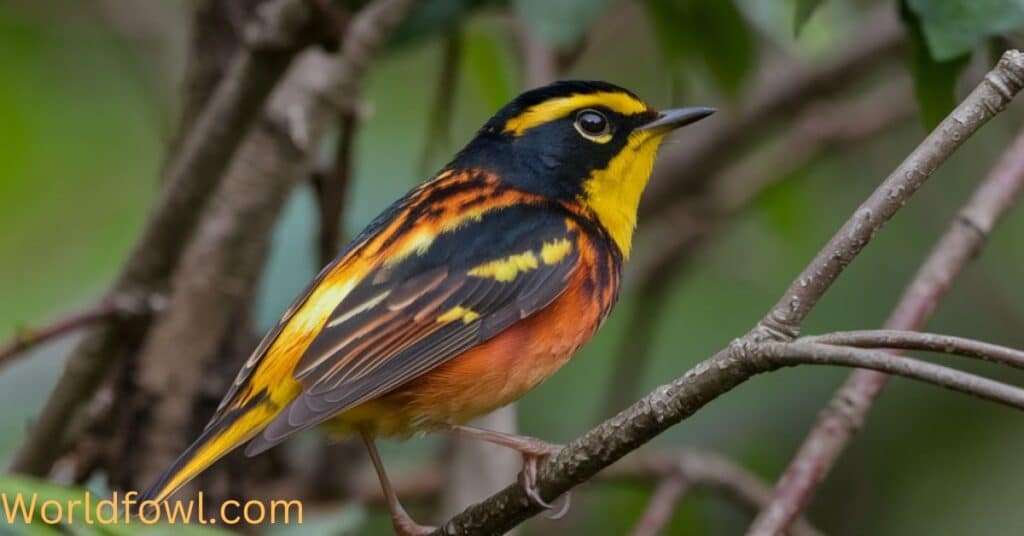
The Cape May Warbler (Setophaga tigrina) is a colorful warbler with distinctive tiger-like striping on its yellow breast.
Key Features:
- Length: 4.7-5.1 inches
- Wingspan: 7.5-8.3 inches
- Weight: 0.3-0.5 ounces
Habitat and Behavior:
- Found in coniferous forests during breeding season, more varied habitats during migration
- Feeds on insects and sometimes nectar
- Has a high-pitched, thin song
Best Time to Spot: Cape May Warblers are migrant warblers in Ohio, typically seen in May and September.
Common Yellowthroat: The Masked Marshland Resident
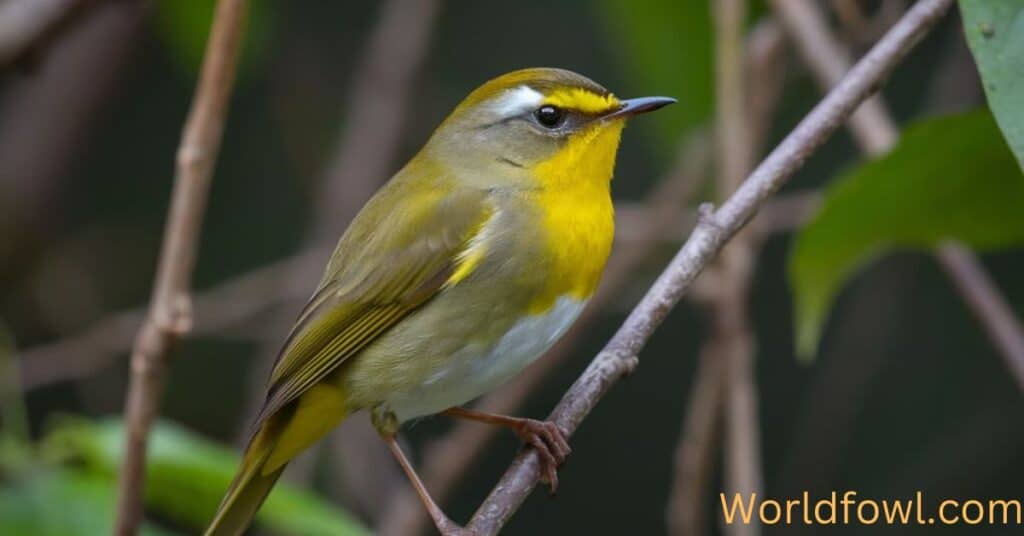
The Common Yellowthroat (Geothlypis trichas) is a small warbler with a bright yellow throat and distinctive black mask (in males).
Key Features:
- Length: 4.3-5.1 inches
- Wingspan: 5.9-7.5 inches
- Weight: 0.3-0.4 ounces
Habitat and Behavior:
- Inhabits marshes, wet thickets, and forest edges
- Known for its “witchety-witchety-witchety” song
- Feeds primarily on insects and spiders
Best Time to Spot: Common Yellowthroats are present in Ohio from late April through early October.
you might also like : Finches in North Carolina – The Complete Guide
Connecticut Warbler: The Secretive Ground-Dweller
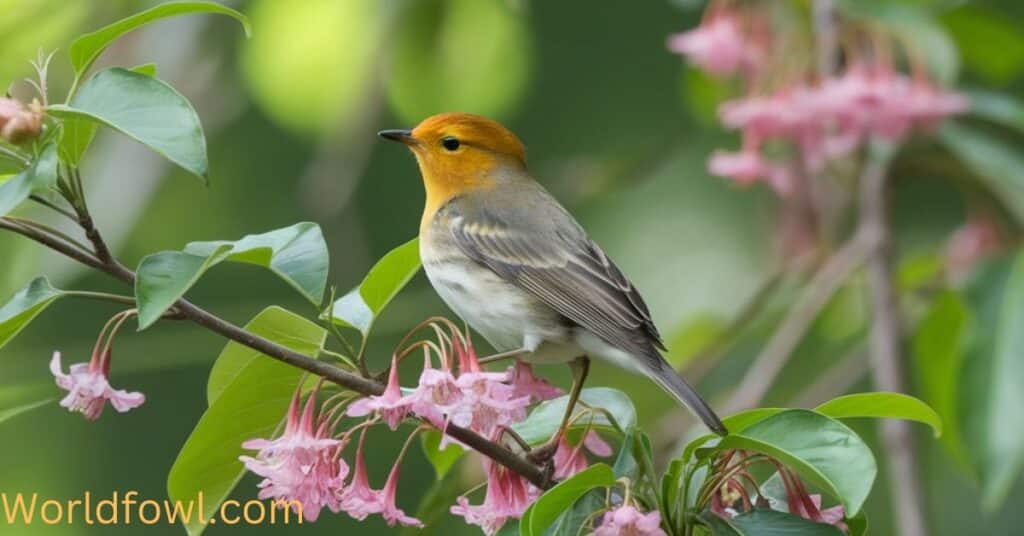
The Connecticut Warbler (Oporornis agilis) is a large warbler with a distinctive gray hood and yellow underparts.
Key Features:
- Length: 5.5-6.3 inches
- Wingspan: 7.5-9.1 inches
- Weight: 0.4-0.5 ounces
Habitat and Behavior:
- Prefers boreal forests and bogs during breeding season
- Often seen walking on the ground rather than hopping
- Has a loud, ringing song
Best Time to Spot: Connecticut Warblers are rare migrant warblers in Ohio, occasionally seen in late May and early September.
Hooded Warbler: The Yellow-Cheeked Forest Phantom
The Hooded Warbler (Setophaga citrina) is a striking bird with a black hood and bright yellow face.
Key Features:
- Length: 5.1-5.9 inches
- Wingspan: 6.7-8.7 inches
- Weight: 0.3-0.4 ounces
Habitat and Behavior:
- Inhabits understory of mature deciduous forests
- Known for its “weeta-weeta-weeteo” song
- Feeds on insects, often caught in mid-air
Best Time to Spot: Hooded Warblers are present in Ohio from late April through early September.
Kentucky Warbler: The Understory Skulker
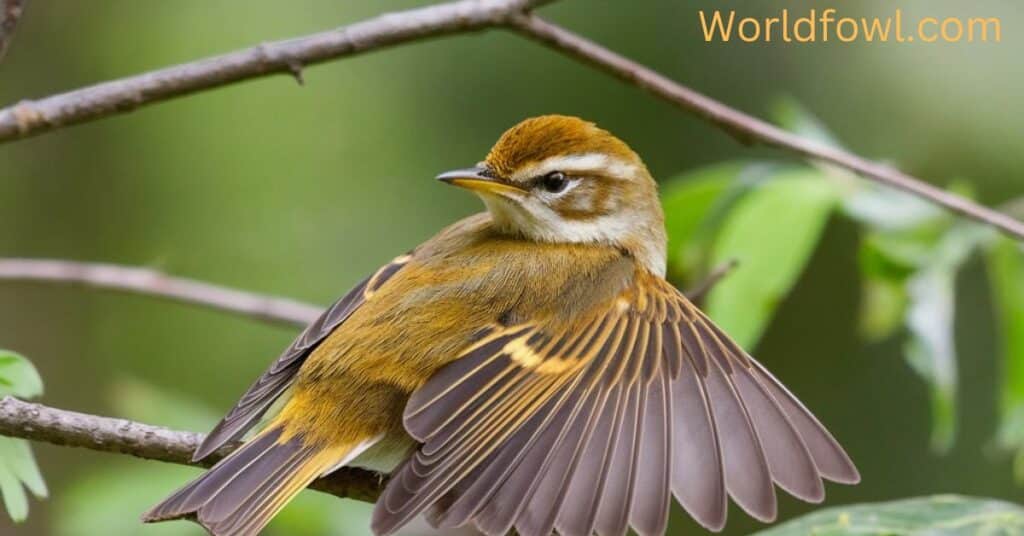
The Kentucky Warbler (Geothlypis formosa) is a large warbler with a bright yellow underside and distinctive black “sideburns.”
Key Features:
- Length: 5.1-5.9 inches
- Wingspan: 7.9-9.1 inches
- Weight: 0.4-0.5 ounces
Habitat and Behavior:
- Prefers dense understory in moist, deciduous forests
- Often seen walking on the ground
- Has a loud, rolling song
Best Time to Spot: Kentucky Warblers are present in Ohio from late April through early September.
Magnolia Warbler: The Black-and-Yellow Wonder
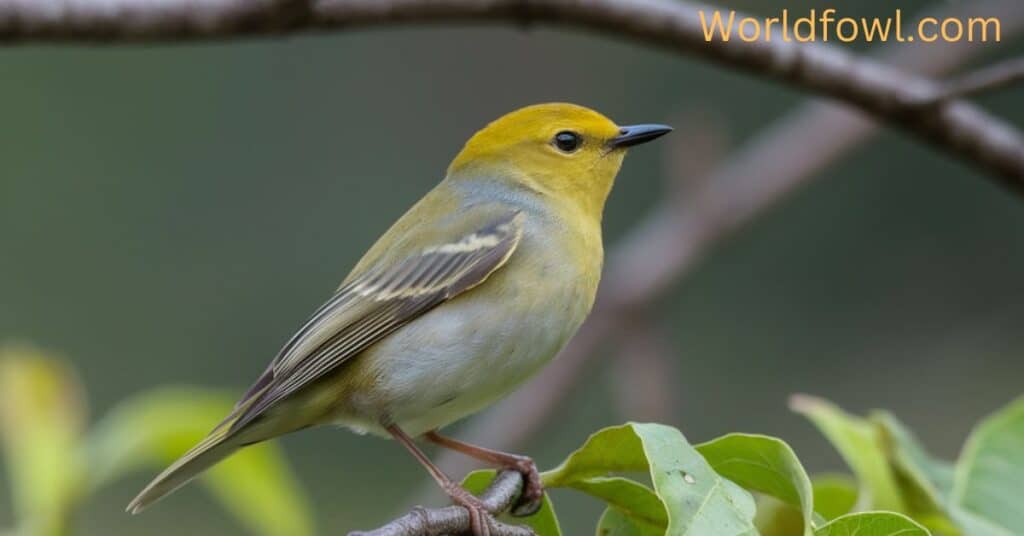
The Magnolia Warbler (Setophaga magnolia) is a striking bird with bold black and yellow patterning.
Key Features:
- Length: 4.3-5.1 inches
- Wingspan: 6.3-7.9 inches
- Weight: 0.2-0.4 ounces
Habitat and Behavior:
- Breeds in coniferous and mixed forests
- Known for its “weeta-weeta-weeteo” song
- Feeds on insects, often caught by hovering or gleaning
Best Time to Spot: Magnolia Warblers are migrating warblers in Ohio, typically seen in May and September.
you can also read : Herons In Michigan – The Complete Guide To 8 Michigan Herons
Mourning Warbler: The Gray-Hooded Recluse
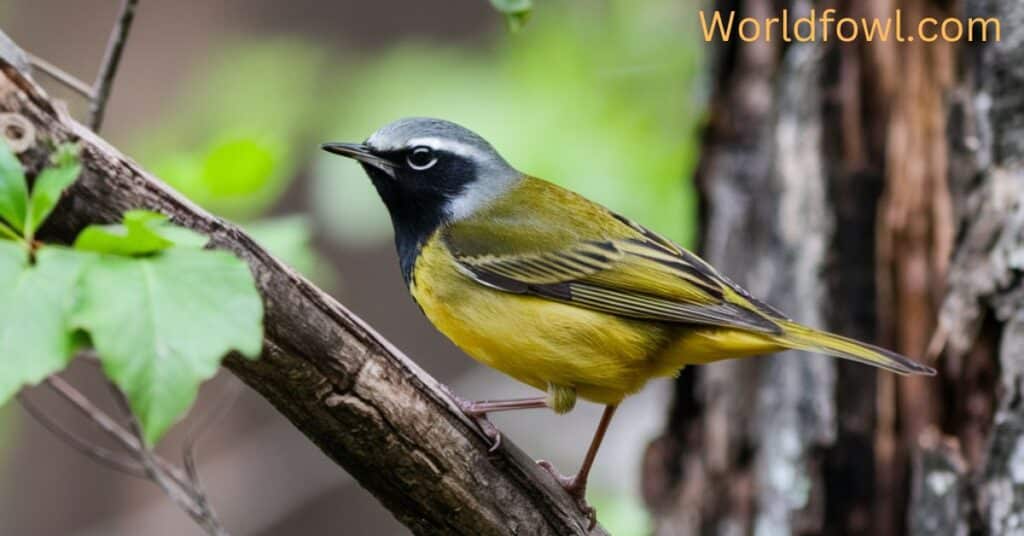
The Mourning Warbler (Geothlypis philadelphia) is a small warbler with a distinctive gray hood and yellow underparts.
Key Features:
- Length: 5.1-5.9 inches
- Wingspan: 7.5-8.7 inches
- Weight: 0.4-0.5 ounces
Habitat and Behavior:
- Prefers dense understory and forest edges
- Often skulks in thick vegetation
- Has a rolling “chorry-chorry-chorry-chorry” song
Best Time to Spot: Mourning Warblers are uncommon migrant warblers in Ohio, typically seen in late May and late August through early September.
Nashville Warbler: The Olive-Backed Songster
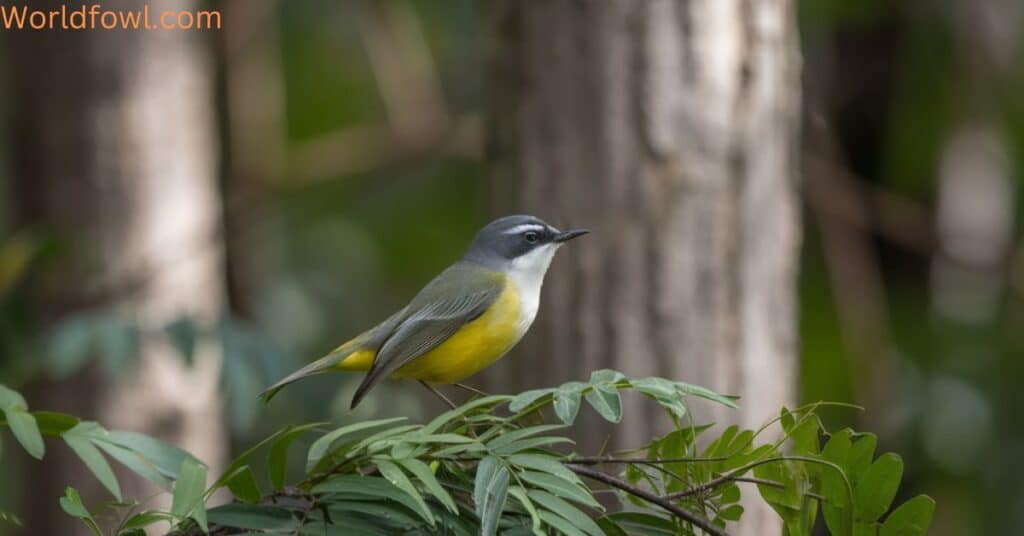
The Nashville Warbler (Leiothlypis ruficapilla) is a small warbler with a gray head, white eye-ring, and yellow underparts.
Key Features:
- Length: 4.3-5.1 inches
- Wingspan: 6.7-7.9 inches
- Weight: 0.2-0.4 ounces
Habitat and Behavior:
- Found in second-growth forests and shrubby areas
- Known for its “see-bit-see-bit-see-bit-see” song
- Feeds on insects and spiders
Best Time to Spot: Nashville Warblers are migrating warblers in Ohio, typically seen in May and September.
Palm Warbler: The Tail-Wagging Migrant
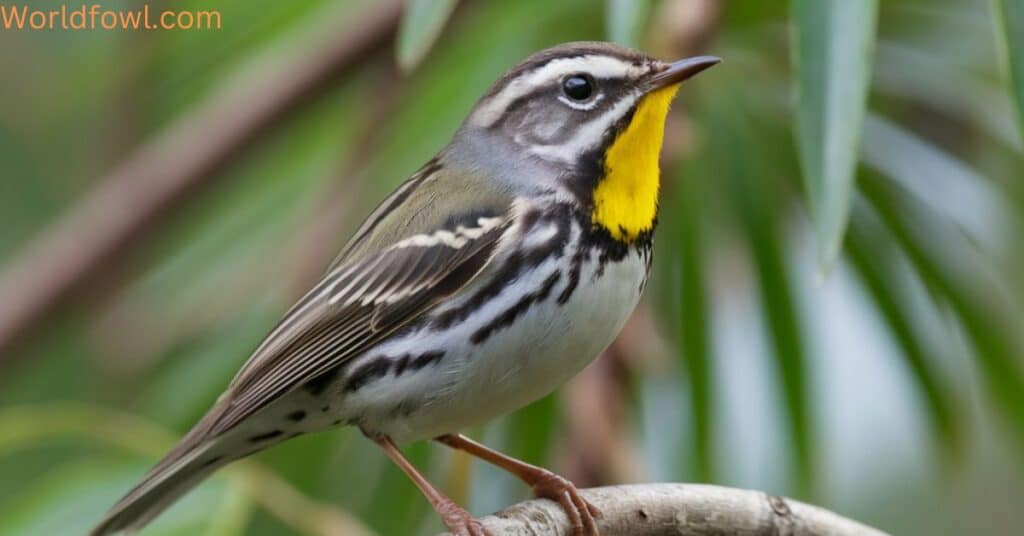
The Palm Warbler (Setophaga palmarum) is a small warbler known for its constant tail-wagging behavior.
Key Features:
- Length: 4.7-5.5 inches
- Wingspan: 7.9-8.7 inches
- Weight: 0.3-0.5 ounces
Habitat and Behavior:
- Found in open areas, including fields and forest edges during migration
- Often seen foraging on the ground
- Has a trilling song and sharp “chek” call
Best Time to Spot: Palm Warblers are migrant warblers in Ohio, typically seen in April-May and September-October.
Pine Warbler: The Conifer Specialist
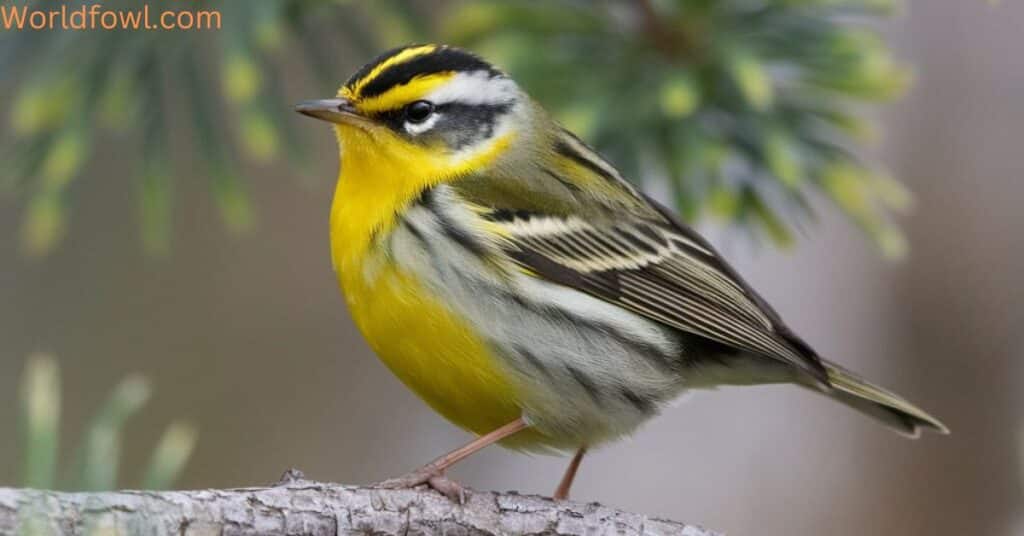
The Pine Warbler (Setophaga pinus) is a yellow-olive warbler closely associated with pine forests.
Key Features:
- Length: 5.1-5.9 inches
- Wingspan: 7.5-9.1 inches
- Weight: 0.3-0.5 ounces
Habitat and Behavior:
- Strongly associated with pine forests
- Often seen foraging on pine needles and cones
- Has a musical trill song
Best Time to Spot: Pine Warblers are present in Ohio from late March through October, with some individuals overwintering.
Prothonotary Warbler: The Golden Swamp Warbler
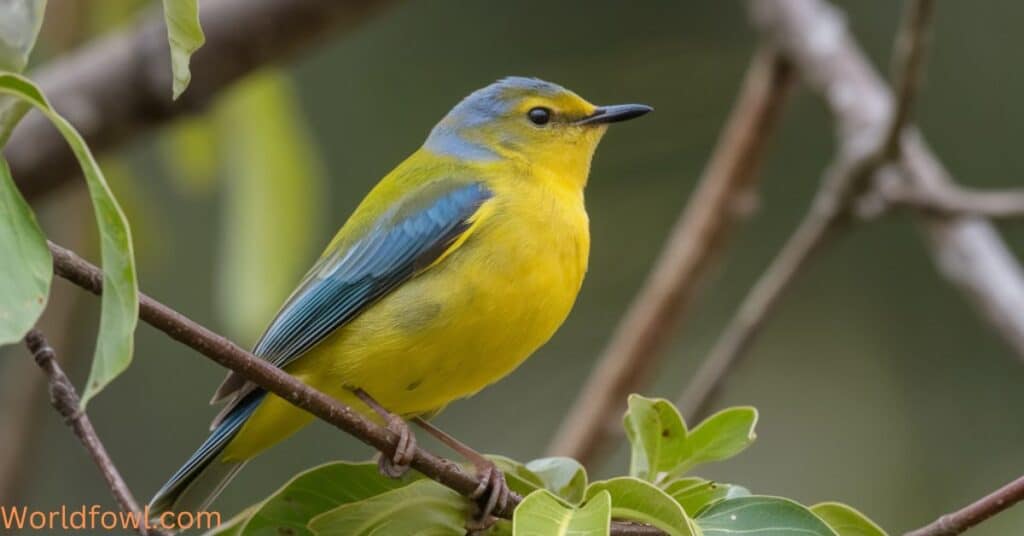
The Prothonotary Warbler (Protonotaria citrea) is a stunning golden-yellow warbler associated with wetland habitats.
Key Features:
- Length: 5.1-5.5 inches
- Wingspan: 8.7-9.4 inches
- Weight: 0.4-0.5 ounces
Habitat and Behavior:
- Inhabits swamps and flooded bottomland forests
- Nests in tree cavities, often over water
- Has a loud, ringing “sweet-sweet-sweet” song
Best Time to Spot: Prothonotary Warblers are present in Ohio from late April through early September.
Wilson’s Warbler: The Black-Capped Charmer
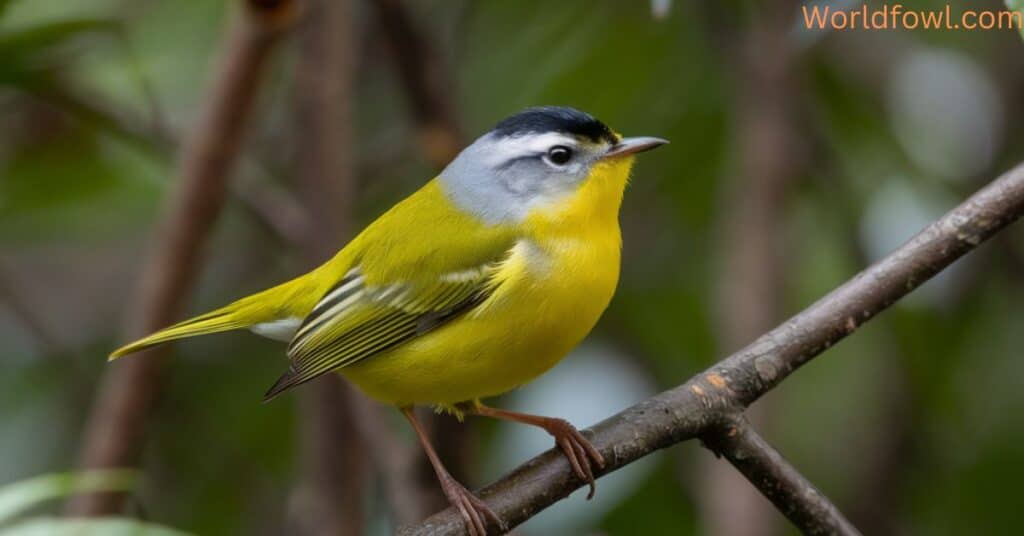
The Wilson’s Warbler (Cardellina pusilla) is a small, bright yellow warbler with a distinctive black cap (in males).
Key Features:
- Length: 4.3-4.7 inches
- Wingspan: 5.5-6.7 inches
- Weight: 0.2-0.3 ounces
Habitat and Behavior:
- Found in shrubby areas and forest edges during migration
- Known for its rapid, chattering song
- Feeds on insects, often caught in mid-air
Best Time to Spot: Wilson’s Warblers are migrant warblers in Ohio, typically seen in May and late August through September.
Yellow Warbler: The Sunshine Bird
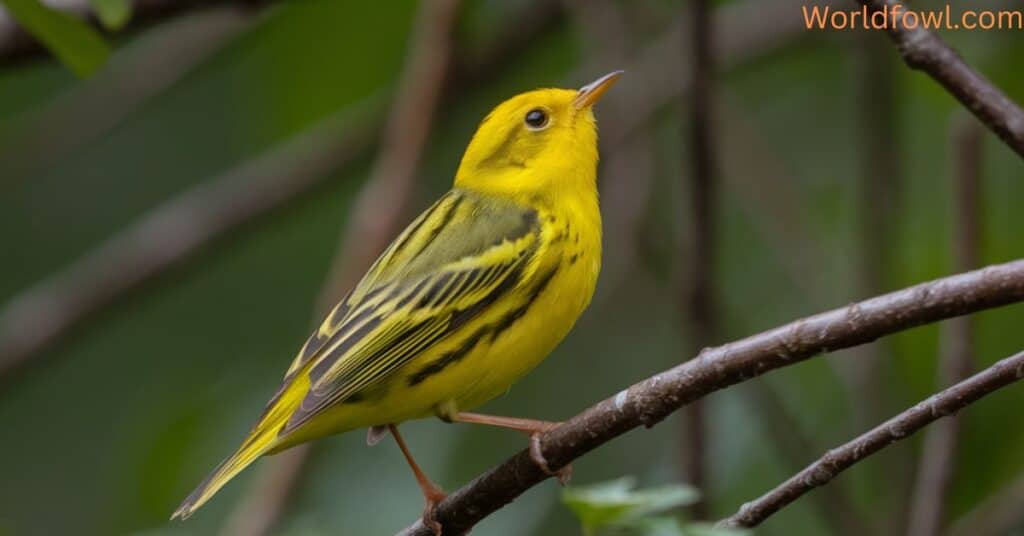
The Yellow Warbler (Setophaga petechia) is one of the most widespread and recognizable warblers, with its bright yellow plumage.
Key Features:
- Length: 4.7-5.1 inches
- Wingspan: 6.3-7.9 inches
- Weight: 0.3-0.4 ounces
Habitat and Behavior:
- Found in a variety of habitats, including wetlands, forest edges, and urban areas
- Known for its “sweet-sweet-sweet-sweeter-than-sweet” song
- Feeds primarily on insects
Best Time to Spot: Yellow Warblers are present in Ohio from late April through early September.
Yellow-rumped Warbler: The Butter-Butted Myrtle
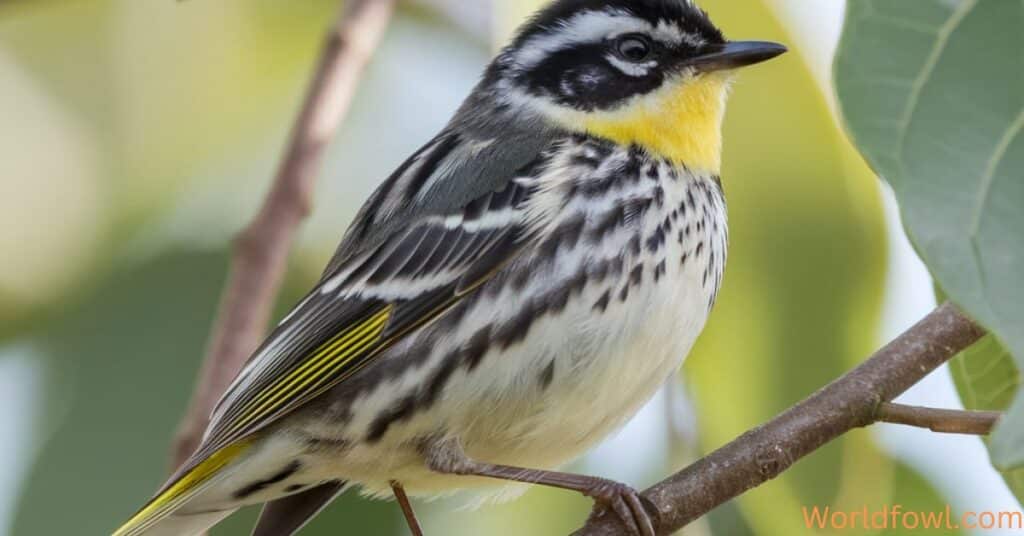
The Yellow-rumped Warbler (Setophaga coronata) is a hardy warbler known for its distinctive yellow rump patch.
Key Features:
- Length: 5.1-5.9 inches
- Wingspan: 7.5-9.1 inches
- Weight: 0.4-0.5 ounces
Habitat and Behavior:
- Adaptable to various habitats, including forests, edges, and urban areas
- Often seen in large flocks during migration
- Feeds on insects and berries
Best Time to Spot: Yellow-rumped Warblers are present in Ohio year-round, with increased numbers during spring and fall migrations.
Cardinals and Grosbeaks: The Robust Seed-Crackers
This group includes some larger songbirds with strong bills adapted for cracking seeds. While not primarily yellow, some species in this group have notable yellow markings.
Dickcissel: The Prairie Canary
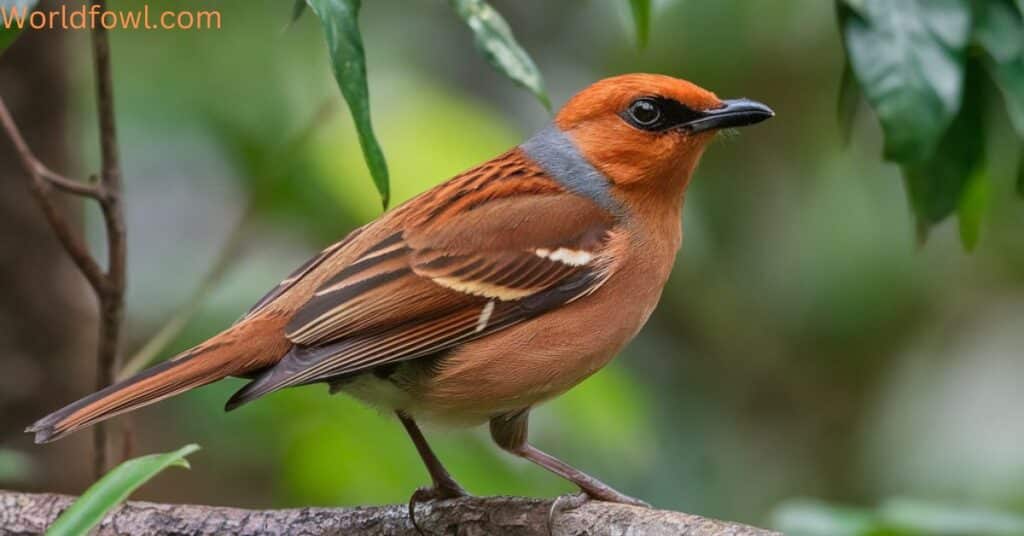
The Dickcissel (Spiza americana) is a sparrow-like bird with a yellow breast and black bib, reminiscent of a miniature meadowlark.
Key Features:
- Length: 5.5-6.3 inches
- Wingspan: 9.8-10.6 inches
- Weight: 0.9-1.2 ounces
Habitat and Behavior:
- Inhabits grasslands, prairies, and agricultural fields
- Known for its “dick-dick-cissel” song
- Feeds on seeds and insects
Best Time to Spot: Dickcissels are summer residents in Ohio, typically present from May through August.
Rose-breasted Grosbeak: The Rosy-Chested Crooner
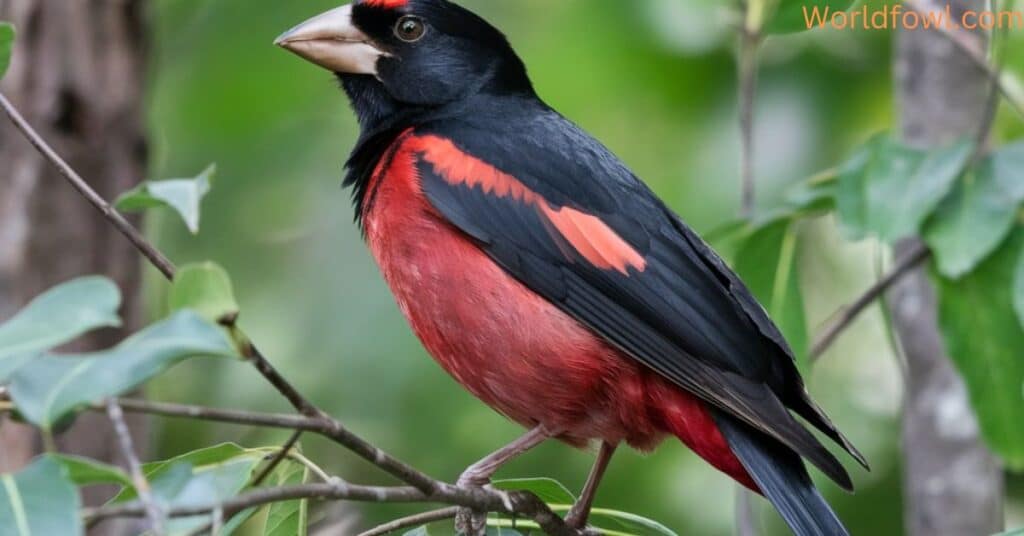
The Rose-breasted Grosbeak (Pheucticus ludovicianus) is a striking bird with a black and white plumage accented by a rosy-red breast in males. While not primarily yellow, it’s worth mentioning due to its yellow wing linings.
Key Features:
- Length: 7.1-8.3 inches
- Wingspan: 11.4-13.0 inches
- Weight: 1.4-1.7 ounces
Habitat and Behavior:
- Found in deciduous and mixed forests
- Known for its robin-like song with added warbles
- Feeds on insects, seeds, and fruits
Best Time to Spot: Rose-breasted Grosbeaks are present in Ohio from late April through early October.
Flycatchers: The Agile Insect-Snatchers
Flycatchers are known for their ability to catch insects in mid-air. While not primarily yellow, some species have notable yellow markings.
Great Crested Flycatcher: The Lemon-Bellied Vocalist
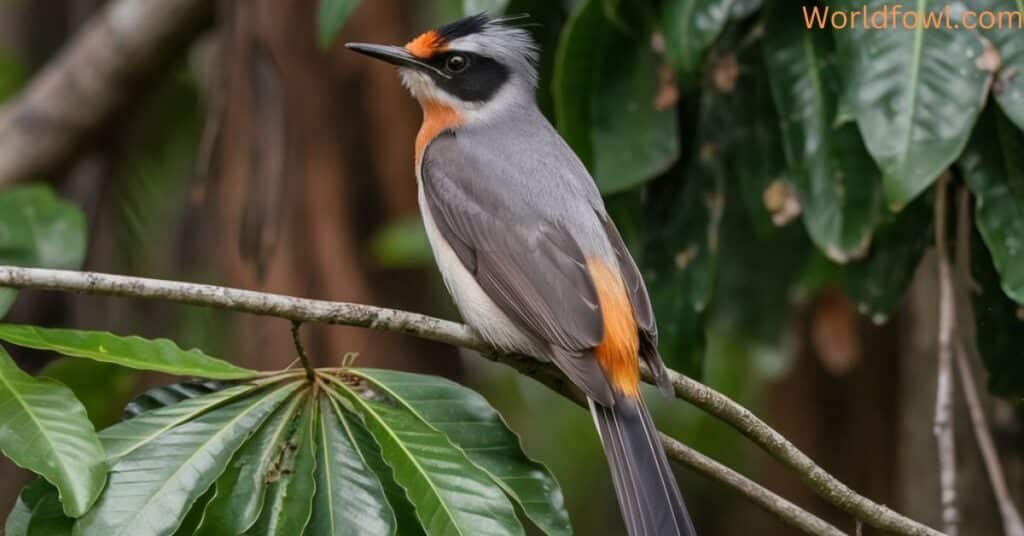
The Great Crested Flycatcher (Myiarchus crinitus) is a large flycatcher with a distinctive lemon-yellow belly.
Key Features:
- Length: 6.7-8.3 inches
- Wingspan: 13.0-14.6 inches
- Weight: 0.9-1.4 ounces
Habitat and Behavior:
- Inhabits deciduous and mixed forests
- Known for its loud, whistling “wheep” call
- Feeds primarily on insects, sometimes small fruits
Best Time to Spot: Great Crested Flycatchers are present in Ohio from late April through early September.
Yellow-bellied Flycatcher: The Boreal Migrant
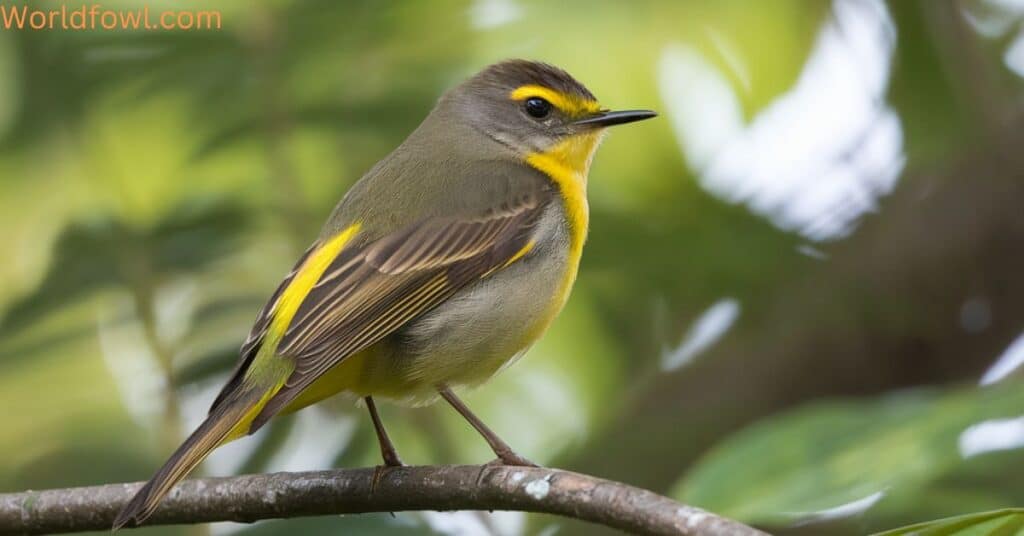
The Yellow-bellied Flycatcher (Empidonax flaviventris) is a small flycatcher with a distinctive yellow wash on its underparts.
Key Features:
- Length: 5.1-5.9 inches
- Wingspan: 7.9-8.7 inches
- Weight: 0.4-0.5 ounces
Habitat and Behavior:
- Breeds in boreal forests, seen in various habitats during migration
- Has a soft “psu-eet” call
- Feeds primarily on flying insects
Best Time to Spot: Yellow-bellied Flycatchers are migrant warblers in Ohio, typically seen in late May and late August through early September.
Conservation and Birdwatching Tips
Habitat Preservation for Yellow Birds in Ohio
Preserving diverse habitats is crucial for maintaining healthy populations of yellow birds in Ohio. Here are some key conservation efforts:
- Protect wetlands and riparian areas
- Maintain large tracts of mature forests
- Preserve grasslands and prairies
- Create and maintain urban green spaces
- Support sustainable agriculture practices
Best Birding Spots for Yellow Species
Ohio offers numerous excellent locations for spotting yellow birds. Some top spots include:
- Magee Marsh Wildlife Area
- Cuyahoga Valley National Park
- Shawnee State Forest
- Ottawa National Wildlife Refuge
- Mohican State Park
Seasonal Guide: When to Spot These Yellow Beauties
| Season | Best Birds to Spot |
| Spring (March-May) | Warblers, Orioles, Vireos |
| Summer (June-August) | American Goldfinch, Yellow Warbler, Dickcissel |
| Fall (September-November) | Migrating Warblers, Palm Warbler, Yellow-rumped Warbler |
| Winter (December-February) | American Goldfinch, Evening Grosbeak (during irruption years) |
Ethical Birdwatching Practices
To ensure the well-being of birds and their habitats, follow these ethical birdwatching guidelines:
- Keep a respectful distance from birds and nests
- Use recorded bird calls sparingly and responsibly
- Stay on designated trails to minimize habitat disturbance
- Avoid using flash photography, especially near nests
- Participate in citizen science projects to contribute to bird conservation efforts
Conclusion
The diverse array of yellow birds in Ohio offers a fascinating glimpse into the state’s rich avian biodiversity. From the vibrant American Goldfinch to the elusive Prothonotary Warbler, these golden-hued species play crucial roles in Ohio’s ecosystems. By appreciating and protecting these beautiful birds and their habitats, we can ensure that future generations will continue to enjoy the sight of yellow wings flitting through Ohio’s forests, fields, and wetlands.
As you explore the world of yellow birds in Ohio, remember that each sighting is a unique opportunity to connect with nature and contribute to our understanding of these remarkable creatures. Whether you’re a seasoned birder or a casual observer, the joy of spotting a bright yellow warbler or hearing the melodious song of a meadowlark is an experience that can enrich your life and deepen your appreciation for the natural world around us.
Additional Resources
To further your knowledge and enjoyment of yellow birds in Ohio, consider exploring these resources:
- Field Guides and Birding Apps:
- The Sibley Guide to Birds
- National Geographic Field Guide to the Birds of North America
- Merlin Bird ID (free app by Cornell Lab of Ornithology)
- eBird (free app for recording and exploring bird sightings)
- Local Audubon Societies and Birding Groups:
- Ohio Ornithological Society
- Audubon Ohio
- Black Swamp Bird Observatory
- eBird and Citizen Science Opportunities:
- eBird.org: Report your bird sightings and explore data from other birders
- Project FeederWatch: Contribute to winter bird population research
- Breeding Bird Survey: Participate in long-term monitoring of breeding bird populations
By utilizing these resources and continuing to explore the world of yellow birds in Ohio, you’ll not only enhance your birdwatching skills but also contribute to the conservation and understanding of these beautiful creatures. Happy birding!

Henry James is a seasoned blogger and a passionate storyteller on “World Fowl.” With years of experience crafting engaging content, he brings a unique blend of expertise and creativity to his writing. Henry specializes in exploring diverse topics with depth and clarity, captivating readers worldwide.

